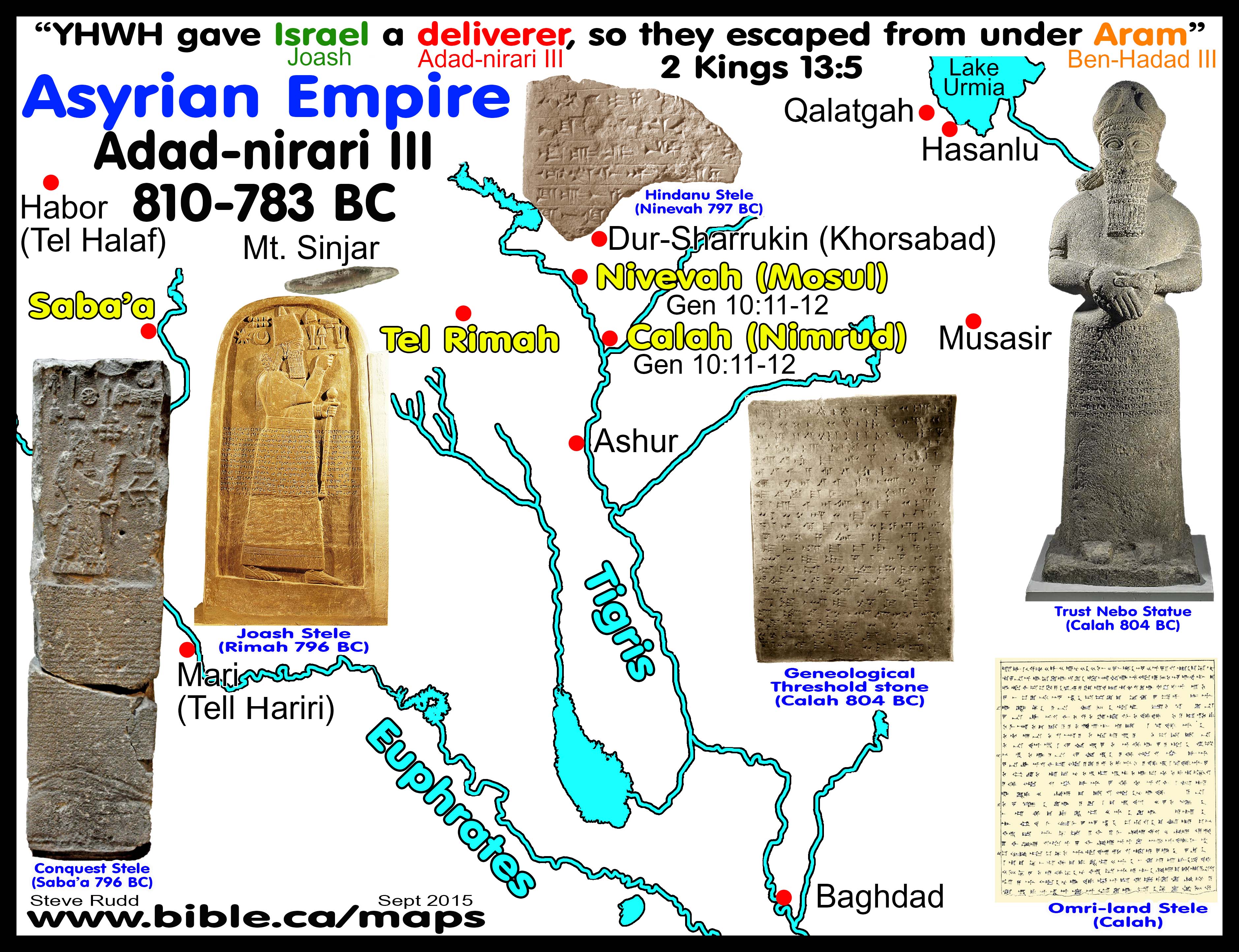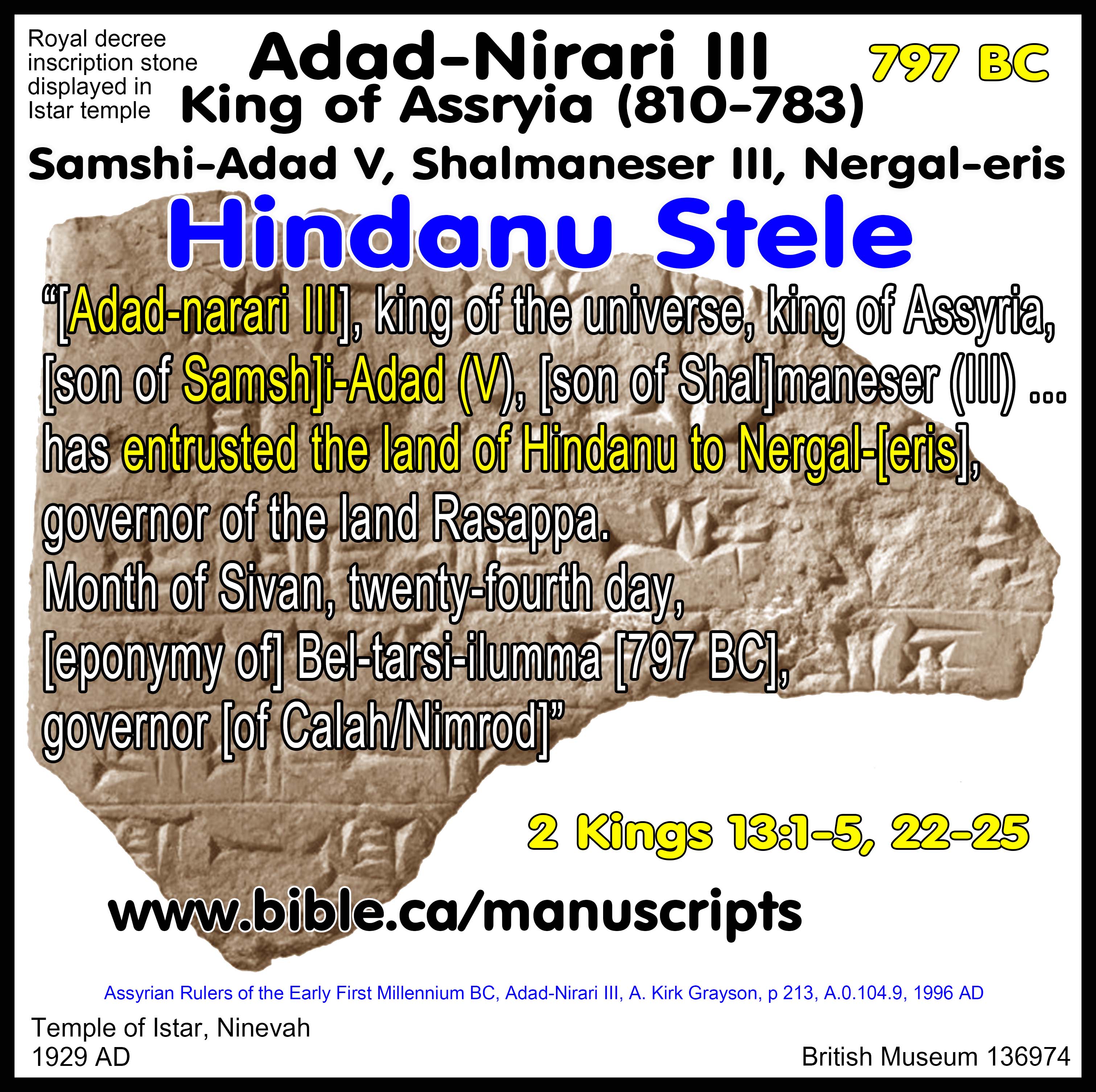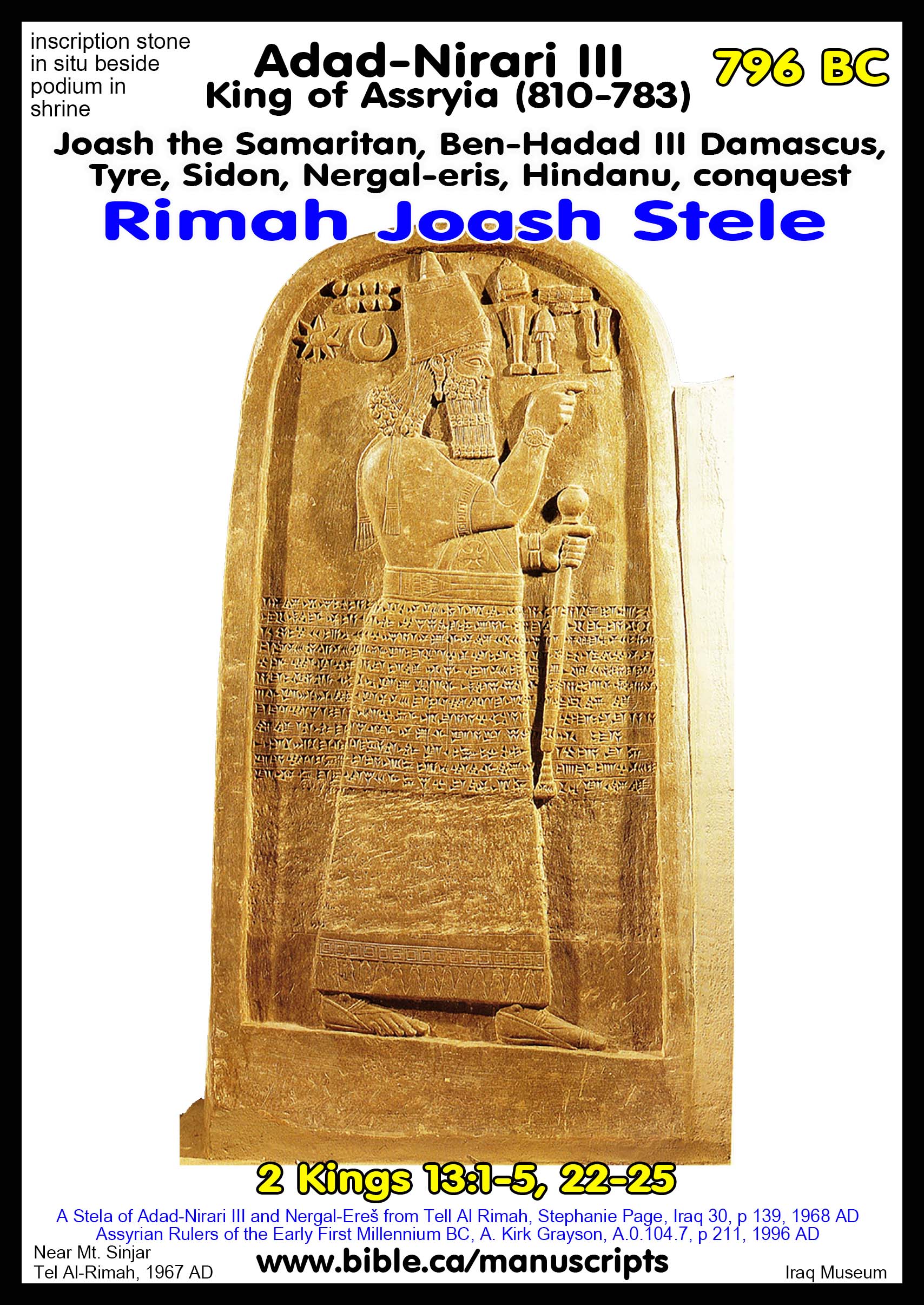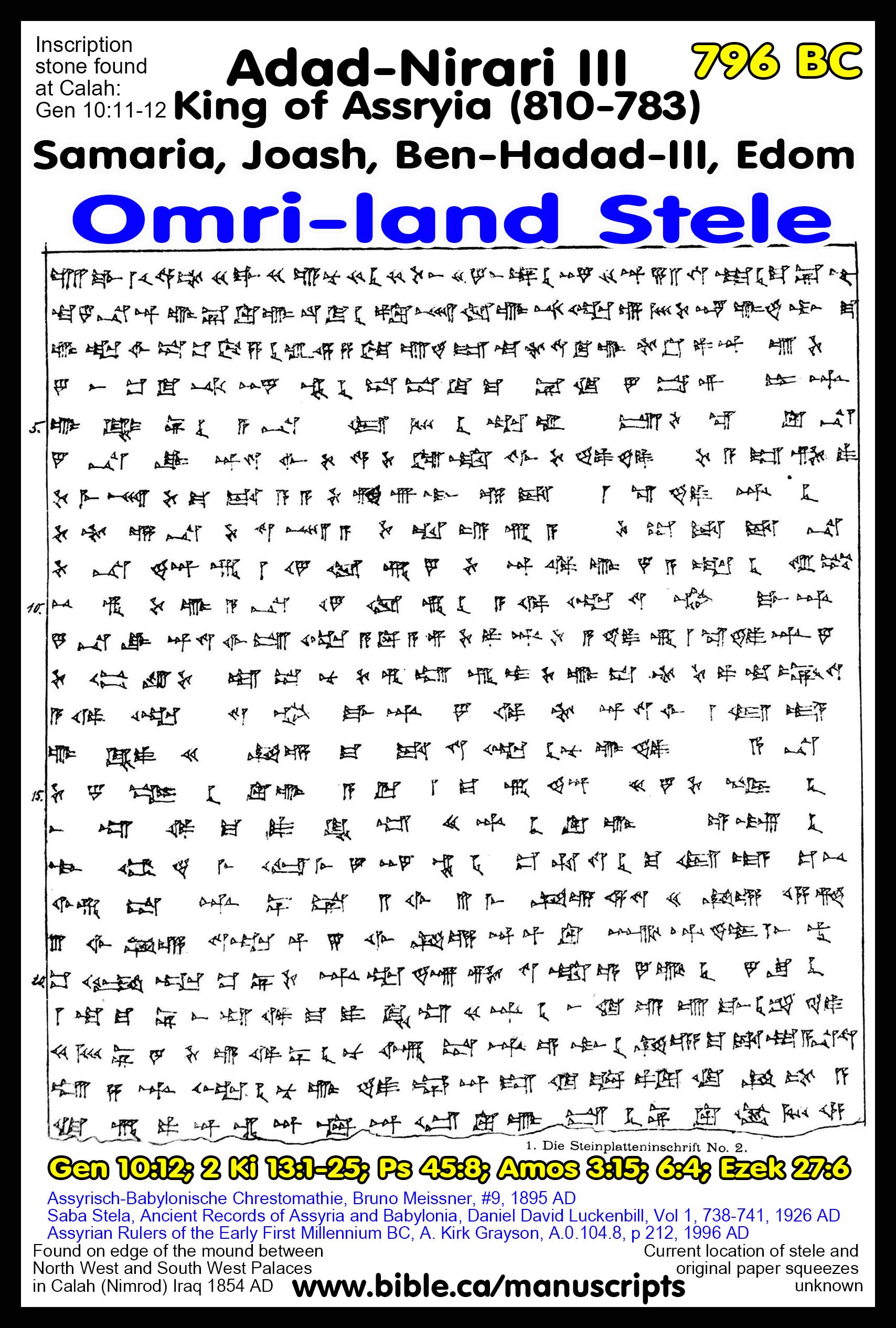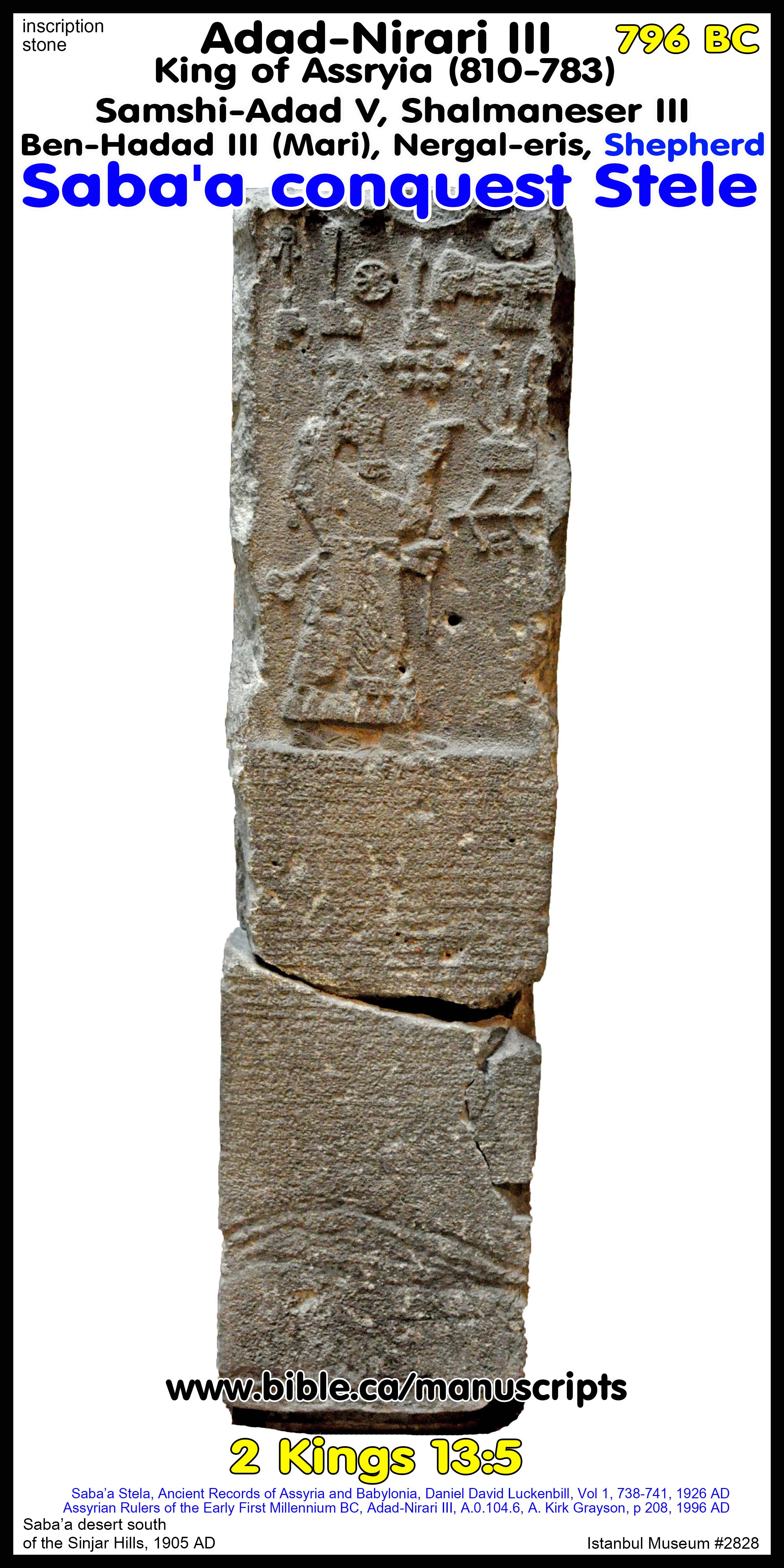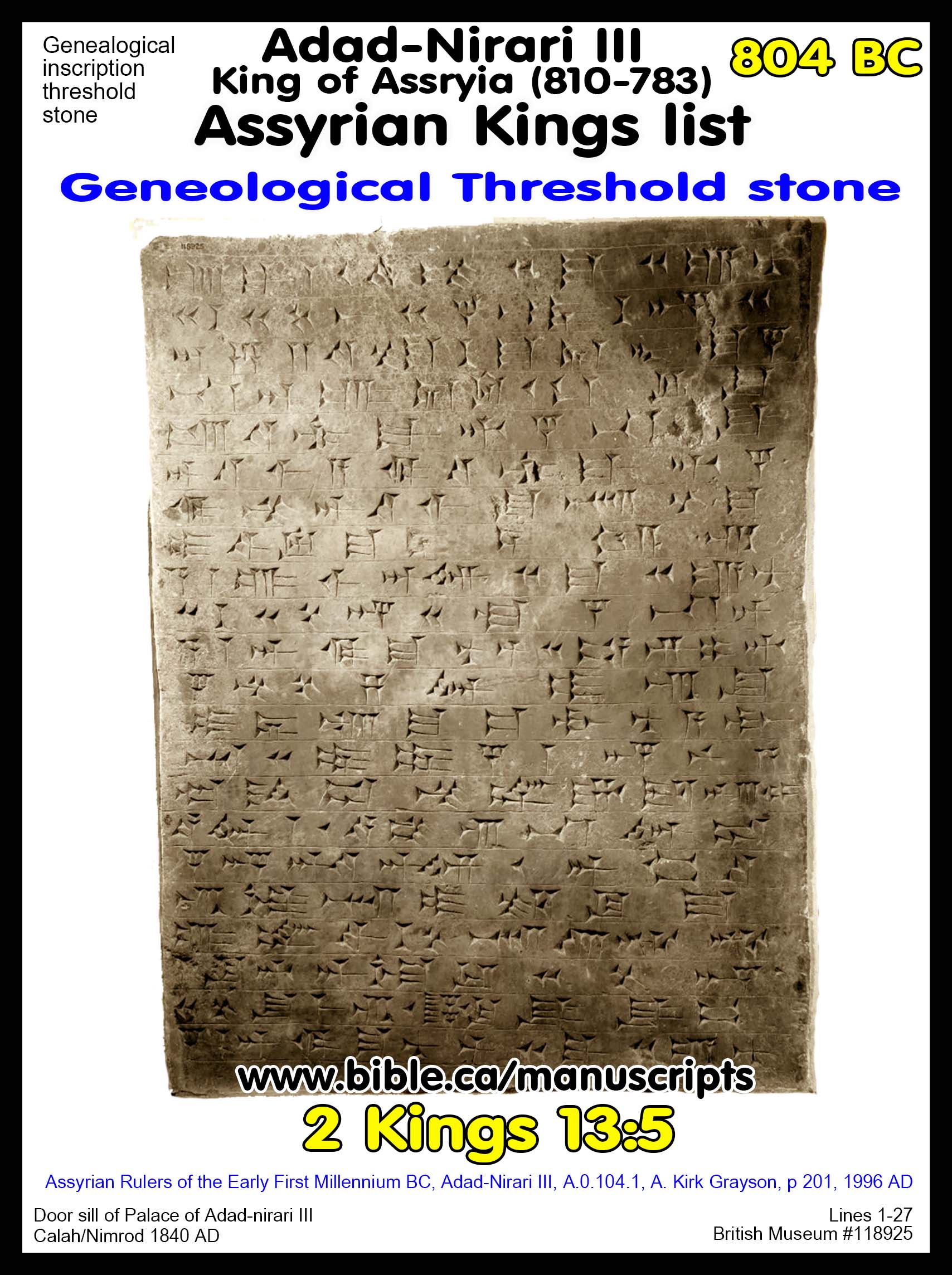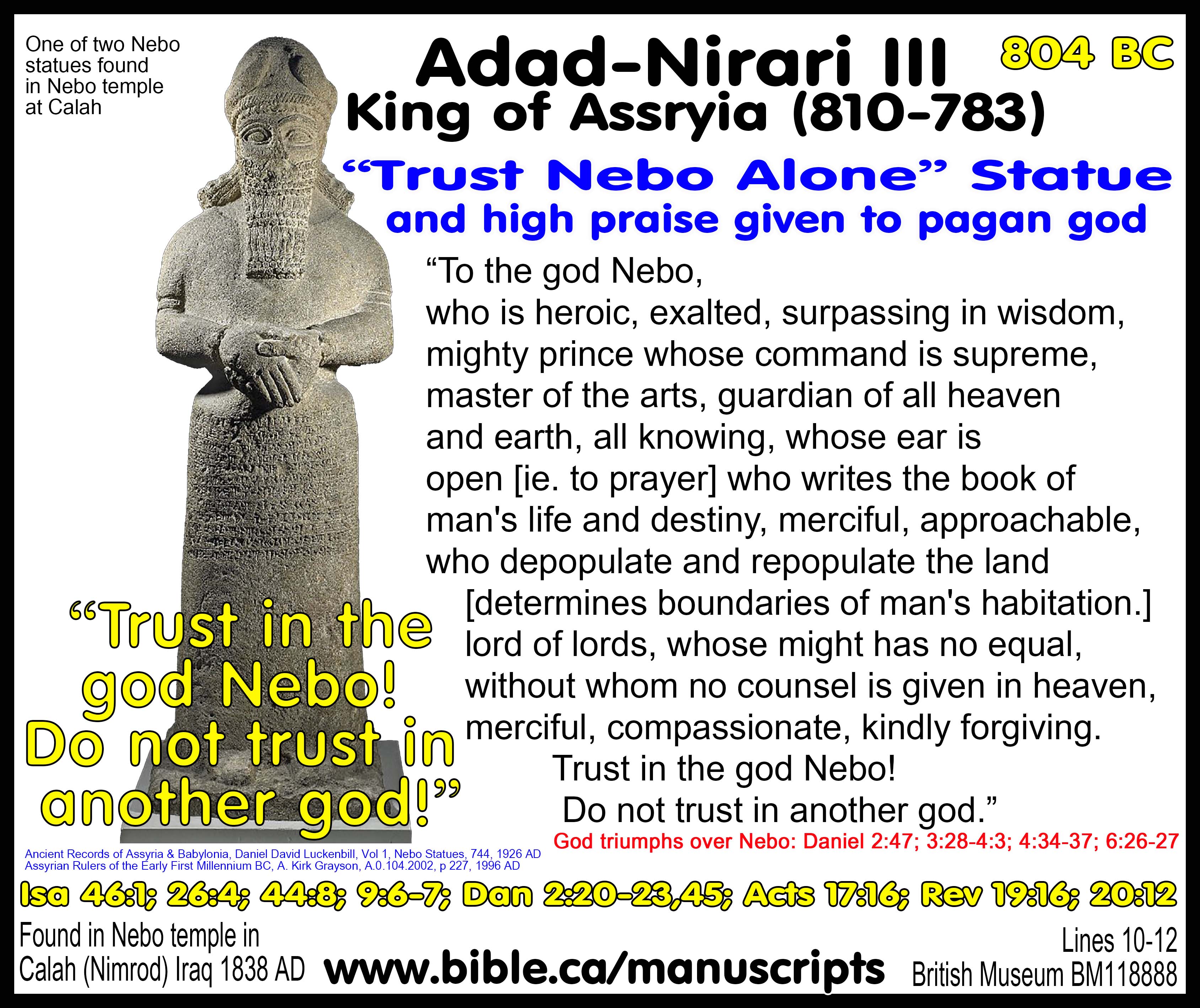Adad-Nirari III, King of Assyria (810-783)
"Hindanu Stele" Royal Decree of 797 BC
|
Adad-Nirari III (810 - 783 BC) "The unknown deliverer" |
||
|
2 Kings 13:5 |
||
|
"YHWH gave Israel King Jehoahaz & Joash (Israel) |
a deliverer King Adad-nirari III (Assyria) |
they escaped Aram" King Ben Hadad III (Aram) |
Two sided tablet stele set up to announce the land of Hindanu is granted by Adad-nirari to Nergal-eris the governor.
|
Temple Statue of Nebo of Adad-nardi III: 804 BC
"[Adad-narari III], king of the universe, king of Assyria, [son of Samsh]i-Adad (V), [son of Shal]maneser (III) … Decree: he (ie. Adad-Narair) has entrusted the land of Hindanu to Nergal-[eris], governor of the land Rasappa. Month of Sivan, twenty-fourth day, [eponymy of] Bel-tarsi-ilumma [797 BC], governor [of Calah/Nimrod]" (Hindanu Stele Adad-nirari III, 797 BC)
This text is engraved on a stone tablet found in the temple of Istar at Nineveh. |
|
Digging up Bible stories! The Hindanu Stele allows us to firmly date the Saba'a conquest Stele to 796 BC which confirms the story of where God delivered Israel out of the hand of Ben-Hadad III (son of Hazael), king of Aram in 2 Kings 13:5. God sent Israel (Jehoahaz and Joash, Samaria) a deliverer (Adad-nirari III, Assyria) they escaped Aram (Ben Hadad III, Aram)
Detailed outline on Adad-Nirari III "What we read in the book, we find in the ground" |
Introduction:
- The Hindanu Stele from Calah/Nimrod was a royal proclamation in 797 BC written under the authority of the Assyrian king Adad-nirari III that grants Nergal-[eris], governor of the land Rasappa, a new parcel of lands under his governorship
- This text is engraved on a stone tablet found in the temple of Istar at Nineveh.
- Adad-nirari III Decrees: I have "entrusted the land Hindanu to Nergal-[eris], governor of the land Rasappa."
- The ancient dating system used what is called an "eponymy"
- Each year was recorded as an "eponymy" of a different ruler.
- On the Hindanu Stele the date is recorded as the year of "Bel-tarsi-ilumma".
- The date on the Hindanu Stele "Month of Sivan, twenty-fourth day, [eponymy of] Bel-tarsi-ilumma" translates to 797 BC.
- The reason this stele is important is that it helps us date another, far more important archeological Saba'a Stele which records the exact events of 2 Kings 13:5.
- "The Lord gave Israel a deliverer, so that they escaped from under the hand of the Arameans; and the sons of Israel lived in their tents as formerly." (2 Kings 13:5)
- That deliverer was none other than Adad-nirari III, king of Assyria!
- From archeology we can date this bible event to 796 BC, one year after Hindanu Stele was set up granting the land of Hindanu to governor Nergal-eris.
- Hindanu Stele helps us confirm the story of where God delivered Israel out of the hand of Ben-Hadad III (son of Hazael), king of Syria in 2 Kings 13:5
I. The Bible story of God saving Israel from Syrian through Adad-Nirair in 797 BC
- Adad-nirari III is specifically but indirectly referenced in 2 Kings 13:5 as the "deliverer" sent by God to save Israel from Damascus.
- The entire story is told here: 2 Kings 13:1-5; 24-25
- "In the twenty-third year of Joash the son of Ahaziah, king of Judah, Jehoahaz the son of Jehu became king over Israel at Samaria, and he reigned seventeen years. He did evil in the sight of the Lord, and followed the sins of Jeroboam the son of Nebat, with which he made Israel sin; he did not turn from them. So the anger of the Lord was kindled against Israel, and He gave them continually into the hand of Hazael king of Aram, and into the hand of Ben-hadad the son of Hazael. Then Jehoahaz entreated the favor of the Lord, and the Lord listened to him; for He saw the oppression of Israel, how the king of Aram oppressed them. The Lord gave Israel a deliverer, so that they escaped from under the hand of the Arameans; and the sons of Israel lived in their tents as formerly." (2 Kings 13:1–5)
- "When Hazael king of Aram died, Ben-hadad his son became king in his place. Then Jehoash the son of Jehoahaz took again from the hand of Ben-hadad the son of Hazael the cities which he had taken in war from the hand of Jehoahaz his father. Three times Joash defeated him and recovered the cities of Israel." (2 Kings 13:24–25)
- The Saba'a Stele (with the help of the Hindanu Stele) confirms the Bible as true history!
II. About the Hindanu Stele from Calah/Nimrod: A royal proclamation in 797 BC
- This is catalogued by Grayson as A.0.104.9.
- "Fragment of inscribed stone stela, being a grant of the province of Hindanu to Nergal-eresh as governor by Adad-nirari III, king of Assyria; horizontal incised ruled cuneiform inscription on both sides; incised snake design along the edge; surfaces heavily burnt in antiquity" (British Museum)
- "This text is engraved on a stone tablet found in the temple of Istar at Nineveh. It is clear from the text that the tablet was on display in that temple (rev. 22) and the reason it was on display is that it is the official record of a royal decree granting the province of Hindanu to Nergal-eris. Normally royal decrees are not included in this series but I have decided to include this document because some of it is very much like a royal inscription in format and because it is important for the understanding of the other steles in which Nergal-eris appears (see the introduction above). The text begins with the royal name and genealogy (obv. 1-3). It then gives the wording of the decree granting Hindanu to Nergal-Eris (obv. 4-5). There follows a lengthy sequence of statements, some similar to legal phrases in contracts, threatening future challengers of this decree with the wrath of king and god (obv. 6 — rev. 21a). These passages are somewhat repetitive. Then there is a paragraph in which divine curses are called down upon anyone who would remove the stone tablet from the temple of Istar and destroy or hide it in any way (rev. 21b-33). This is followed by the date, 797 BC (rev. 34-35). The text should really end at this point. However, after a blank line, the author resumes his threats against future challengers of the decree (rev. 3638). While the text breaks off after only three lines, there would have been room on the original tablet for further lengthy statements on this theme. That most of the document is concerned about future attempts to revoke or ignore the royal decree is understandable in the historical context. In the eighth century BC there were some very powerful officials, among them Nergalerg, who were vying with the crown and with each other for territorial power (see Grayson, CAH 3/1 pp. 273-74). It was, then, viewed as a real possibility that Hindanu might be taken away from Nergal-Eris in defiance of the king. The main part of the broken tablet is in the Iraq Museum, while a small piece, which clearly must join it, is in the British Museum (BM 136974 = 81-2-4,29) —see Reade and Walker. The original tablet, according to Reade and Walker, would have measured over 41 cm in height and 18.7 cm in width. The text on the large piece was collated from a photo by Postgate, Orientalia NS 42. The text on the small piece was collated by Walker from the original and by me from the published photo. The join shows that on the rev. there is one less line missing, between rev. 20-25, than Thompson had estimated. Thus the line numbers in this edition are one lower from this point on." (Assyrian Rulers of the Early First Millennium BC, Adad-Nirari III, Hindanu Stele, A. Kirk Grayson, p 213, A.0.104.9, 1996 AD)
III. Translation of "Hindanu Stele" of Adad-Nirari III:
|
"[Adad-narari (III), great king], strong king, king of the universe, king of Assyria, [son of SamS]I-Adad (V), strong king, king [of the universe], king of Assyria, [son of Shal]maneser (III), king of the four quarters: (lines 4-5) Decree: he has entrusted the land Hindanu to Nergal-[eris], governor of the land Rasappa. The ilku is under his authority. (lines 6-10) Whoever lays claim against the provisions of the decree, which is (in favour) of Nergal-eris, governor of the land Rasappa (and) governor [of the land Hindanu], [...] his agent. Whoever [... files a] suit before the king against Nergal-eris [... ]: (lines 11-14) Now he must not speak calumnies, [for the king] has wholeheartedly entrusted [the land Hindanu] to [Nergal-eris], governor of the land Rasappa. The gods Adad and Ber [...] (lines 15-23) (continued below) |
A later prince whom [Assur] will name [for] the sovereignty of Assyria: he must not cancel (lit. "remove") the provisions of this document, he must not remove the people of the land Hindanu from the authority of Nergal-Eris, governor of the land Rasappa, to add them to another province and (20) entrust them to someone else. For future days, for eternity, they are included with the province of Rasappa [and] the governor of Rasappa [...] [...]Lacuna (about 5 lines (lines rev. 1-14) Whoever, either prince, [or ...], or brother of the king, [or ...], or vizier, or [...], or master, or commoner, or [...], (5) stands (to testify), the testimony [which he declares] must be good. Whoever (he be), he must not speak bad [testimony] concerning the people of the land Hindanu before [the king, his lord]. In the presence of the king, his lord, he must not [say]: "Remove the people of Hindanu from the authority of Nergal-[ari], (10) governor of the land Rasappa. Put them under the authority of someone else." (If he does), may the king, his lord, banish him from his palace with curses (lit. "bad words") and maledictions (lit. "not-good-oaths"). As long as he lives may he not be allowed to re-enter the palace. May he (the king) remove his province (from his authority) and hand it over to his enemy. (lines rev. 15-18) Whoever says concerning the land Hindanu, "Remove the land Hindanu from the authority of the governor of [Rasappa]": may the god Marcluk, the great lord, glare at him angrily (and) [ordain for him] an evil fate forever. (lines rev. 19-21a) The king swears by god that he has entrusted the land Hin[danu ...] to Nergal-eris. [No one] may take (it from him). [...] x x x [...] Lacuna (lines rev. 21b-33) Whoever [removes this] document from the presence of the divine mistress of Nineveh [and] throws it in water, or burns it with fire, or buries it in the earth, or (25) puts it in another place, or throws it into a Taboo House where it is inaccessible: may the deities Assur, Samag, Nabu, Marduk, Enlil, father of the gods, Ninurta, the warrior, Nergal, the lord of judgment, the Assyrian Mar, (all) these great gods, (30) glare angrily at him and eradicate [his name, his seed], and his offspring from the land. May they clothe his body with leprosy as with a garment. (lines rev. 34-35) Month of Sivan, twenty-fourth day, [eponymy of] Bel-tarsi-ilumma [797 BC], governor [of Calah/Nimrod]. rev. 36-38) Whoever says in the presence of the king, "Remove the land Hindanu from the authority of Nergal-eris, governor of the land Rasappa": according to this document [...] [...] Lacuna" (Assyrian Rulers of the Early First Millennium BC, Adad-Nirari III, Hindanu Stele, A. Kirk Grayson, p 214, A.0.104.9, 1996 AD)
Conclusion:
- In 797 BC, Assyrian king Adad-nirari III gives governor Nergal-eris the land of Hindanu.
- This allows us to accurately date the more important Saba'a stele to 796 BC, the same year Adad-nirari III saved Israel (ten northern tribes) from Ben-Adad II, king of Aram at Damascus.
- Adad-nirari III is specifically but indirectly referenced in 2 Kings 13:5 as the "deliverer" sent by God to save Israel from Damascus.
- The Hindanu Stele allows us to accurately date the Saba'a Stele to 796 BC
- The Saba'a Stele tells the exact story found in the Bible: 2 Kings 13:1-5; 24-25
- The Saba'a Stele (with the help of the Hindanu Stele) confirms the Bible as true history!
- What you read in the book, you find in the ground! Find me a church to attend in my home town this Sunday!
|
2 Kings 13:5 |
||
|
"YHWH gave Israel King Jehoahaz & Joash (Israel) |
a deliverer King Adad-nirari III (Assyria) |
they escaped Aram" King Ben Hadad III (Aram) |
|
Conquest Stela of Adad-Nirari III (810 - 783 BC) Detailed outline on Adad-Nirari III . |
||
|
Religious and dynastic Stela of Adad-Nirari III (810 - 783 BC) |
||
By Steve Rudd: Contact the author for comments, input or corrections.


